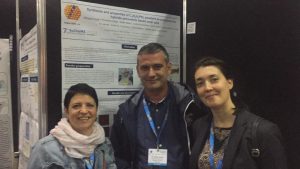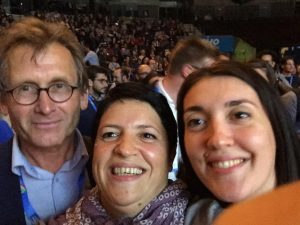New approaches for the synthesis of hybrid organic-inorganic perovskit (HOIP)-type materials with possible ferroelectric properties for photovoltaic applications
Project Director: Dr. Mihaela FLOREA
The ambitious goal of PEROFER proposal is to design new approaches for the synthesis of hybrid organic-inorganic perovskite-type materials with possible ferroelectric properties for photovoltaic applications. The advantages of hybrid organic-inorganic perovskite (HOIP) are: i) their low cost, ii) use of Earth-abundant and available elements, and iii) low-temperature processing synthetic routes through which they can be produced. Nevertheless, before commercialization of HOIP for photovoltaic technology there are some scientific and technical drawbacks which must be overcome: i) poor reproducibility of the HOIP materials; ii) lack of uniformity of the perovskite layers; iii) rapid degradation in moist environments (especially water); iv) lack of long-term stability of perovskite solar cells; v) suffers from bandgap larger than the ideal; iv) the use of highly toxic and carcinogenic Pb element with high environmental impact.
To give a chance to hybrid organic-inorganic perovskite onto the market, the development of very efficient, cost-effective and environmental friendly synthesis method of HOIP is highly desired.
The challenges of PEROFER proposal are original and innovative, and require scientific breakthroughs in fundamental phenomena and significant technological developments.
The principal scope of the PEROFER project is to find new approaches for the synthesis method of hybrid inorganic-organic perovskite type materials in order to tune its bandgap in such way to maximize the photo response over a large range of visible light spectrum.
The specific objectives of the PEROFER proposal are:
I) A deeper understanding of the most basic processes from the synthesis stage (as nucleation, crystallization, etc.), which will be a valuable asset of this project, aiming to push performance of hybrid perovskite solar cells near the maximum theoretical efficiency of a solar cell.
II) To improve the structural stability- as it has been established that enlargement of the octahedral network significantly influences stability of the HOIP materials, one objective will be to replace the organic cations from A-sitewith different molecules such as: protonated amines; halogenated aromatic amines (halogeno- (F-, Cl-, Br-, I-) derivatives phenethylamines), etc.
III) To bust the ferroelectric properties, by incorporating divalent metal cations (Sr2+, Ba2+, Mn2+, Fe2+, Co2+, Ni2+, Cu2+, Zn2+, Sn2+, Eu2+, etc.) in the inorganic matrix (Me-halide hybridized orbital) as B-site cation and replacing X anion with different ions (F-,Cl-, Br-, I-, (HCOO)-, (BH4)-)
Leader: Mihaela Florea, specialized in material synthesis and surface characterization, in charge with the management and dissemination tasks
Members:
Ioana Pintilie. PhD specialist in electrical and photovoltaic characterization;
Florentina Neatu, PhD, specialist in material synthesis, good experience working with organic molecules; dissemination
Stefan Neatu, PhD, with competence in materials synthesis and characterization;
Cristina Besleaga Stan, PhD, (post-doc) in charge with electrical and photovoltaic characterization
Viorica Stancu, PhD, in charge with chemical preparation and structural characterization; solar cell device fabrication
Andrei Tomulescu, PhD student in charge with chemical preparation of novel halides; solar fabrication and characterization
Lucia Leonat, PhD, in charge with photovoltaic characterisation (AFM, SEM...), solar cells fabrication, thin film characterization, dissemination.
Perovskite solar cells have attracted a lot of attention since their first report in 2009.[1] Over the last 2 years, an unexpected breakthrough and rapid evolution in the field of emerging photovoltaics was reported. The hybrid organic-inorganic perovskite (HOIP) materials with ferroelectric properties for photovoltaic applications are found to be the promising candidates in this regard. Therefore, a new era for the research and development for low-cost photovoltaic have emerged based on hybrid organic-inorganic perovskite (HOIP), currently reaching an efficiency higher than 18%,[2] this year was recorded the highest value of 22,1%.[3]
The poor reproducibility and lack of uniformity of the perovskite from PV make it challenging to obtain high efficiencies. In this context, there are several types of approaches that could be applied for the optimization of the HOIP synthesis for PV applications, like: solvent, compositional, and bandgap engineering. These techniques are seen as prerequisite for the obtainment of the highest PCE HOIP-based PV devices in the future.
In order to achieve the objectives proposed at this stage, PEROFER focused on the production of solar cells, using the perovskite deposition from the solution using different solvents, creating the premise of assembling these solar cells under optimum conditions.
STAGE I -2017
In accordance with the PEROFER project implementation plan, in Stage I entitled "Comparative study of the method of preparation of CH3NH3PbI3 hybrid perovskites type CH3NH3PbI3", the scientific research carried out within this project pursued the following objectives:
- Study of the solvent influence of in the single-step preparation of hybrid perovskites and their characterization;
- Study of the solvent influence on the two-step preparation and their characterizationș
- Preparation of hybrids of type CH3NH3PbI3 by ex-situ methods
At this stage of the project, more than 50 samples were produced, the best efficiency with a value of 11.35% was obtained for the single cell prepared using DMF: DMSO in a molar ratio of 12 to 1.
Regarding the influence of the solvent, it was observed that: (i) the use of CHP or NMP as a solvent is not possible due to the low solubility of the lead iodide, which leads to thin and non-compacted perovskit layers and more than this, favors the production of quantities of the secondary phase; (ii) GBL can be used successfully as both solvent and cosolvent; (iii) DMSO remains the ideal co-solvent for hybrid perovskitic cells and its ability to form a lead iodide complex leads to a very well-crystallized and compacted active layer.
Taking into account the results achieved at this stage of the project and the degree of implementation achieved, we can appreciate that the research activities carried out fully satisfied the proposed objectives.
STAGE II -2018
During this stage we have explored a new A-site cation engineering for the pristine MAPbI2.4Cl0.6 and MAPbI3 perovskite using different organic cations. Among these, imidazolium and methylimidazolium present the most interesting results using the best solvent mixture as determined in the stage I of this project.
Therefore, we systematically investigated the A-cite formulation of MAPbI2.4Cl0.6with imidazolium by gradually replacing the MA with IM, until full replacement of MA. The synthesis of imidazolium iodide with chemical formula C3N2H5I (IMI) as precursor was realized in house by a facile, low cost approach that is detailed in the scientific report. We thoroughly investigated the properties of the mixed organic cation perovskite films by AFM, XRD, SEM, UV-Vis and their influence in solar cells devices.
Figure 1. Synthesis steps of C3N2H5I.
STAGE III -2019
During this stage we have explored new possibilities to improve the efficiency of hybride perovskite based solar cells.
For exemple, by keeping the same deposition conditions and varying only the concentrations of the salts, the aliovalent substitution of Pb2+ by Eu3+ has an impact over the structural and morphological properties. The most important feature of this study is that the presence of Eu in low amounts (i.e. Eu-1%) hindered the formation of residual PbI2 and favorize the formation of a dense perovskite film which can be beneficial for the device stability. However, the surface morphology studies for higher Eu loadings indicate possible pinholes that might lead to less efficient power conversion. The doping process influence slightly the bandgap of the hybrid perovskite thin films but remains in the optimal range for solar cells application. The aliovalent substitution of Pb2+ by Eu3+ was confirmed by XPS analysis, but the isovalent substitution cannot be excluded.


Participare la EUCHEMS Liverpool, 2018
[1] [1]A. Kojima, K. Teshima, Y. Shirai, T. Miyasaka, J. Am. Chem. Soc.2009, 131, 6050; b) H.J. Snaith, J. Phys. Chem. Lett.2013, 4, 3623; c) Q. Dong, Y. Fang, Y. Shao, P. Mulligan, J. Qiu, L. Cao, J. Huang, Science2015, 347, 967; d) J. Berry, T. Buonassisi, D.A. Egger, G. Hodes, L. Kronik, Y.-L. Loo, I. Lubomirsky, S.R. Marder, Y. Mastai, J.S. Miller, D.B. Mitzi, Y. Paz, A.M. Rappe, I. Riess, B. Rybtchinski, O. Stafsudd, V. Stevanovic, M.F. Toney, D. Zitoun, A. Kahn, D. Ginley, D. Cahen,Adv. Mater.2015, 27, 5102
[2] [2] a) N.J. Jeon, J.H. Noh, W.S. Yang, Y.C. Kim, S. Ryu, J. Seo, S.I. Seok, Nature2015, 517, 476; b) W.S. Yang, H.H. Noh, N.J. Jeon, Y.C. Kim, S. Ryu, J. Seo, S.I. Seok, Science2015, 348, 1234.
[3] [3]http://www.nrel.gov/ncpv/images/efficiency_chart.jpg, (last Accessed on 21 March 2017).
1. Heavy doping ceria by wet impregnation: A viable alternative to bulk doping approaches, Mihaela Florea, Daniel Avram, Adrian Maraloiu, Bogdan Cojocaru and Carmen Tiseanu, Nanoscale 10 (2018) 18043-18054, (IF = 7.23, AIS=1.8)
2. Bimodal mesoporous NiO/CeO2-δ-YSZwith enhanced carbon tolerance in catalytic partial oxidation of methane - potential IT-SOFCs anode, Simona Somacescu,Nicoleta Cioatera, Petre Osiceanu, JoseMaria Calderon-Moreno, Corneliu Ghica, Florentina Neațu,Mihaela Florea, Applied Catalysis B, 241 (2019) 393-406, (IF= 11.69, AIS= 1.664)
3. Near infrared emission properties of Er doped cubic sesquioxidesunder near-infrared up-conversion and X-ray excitation, Daniel Avram, Ion Tiseanu, Bogdan S. Vasile, Mihaela Florea, Carmen Tiseanu, Scientific Reports, 2018, accepted (IF= 4.60, AIS= 1.35)
4. Behaviour of Molybdenum-Vanadium Mixed Oxides in Selective Oxidation and Disproportionation of Toluene, Gheorghita Mitran, Florentina Neaţu, Octavian D. Pavel, Mihaela M. Trandafir, Mihaela Florea, Materials, 2019, 12 (5) 748 (IF=2.972)
5. The hysteresis-free behavior of perovskite solar cells from the perspective of the measurement conditions, Nemnes, George; Besleaga, Cristina; Tomulescu, Andrei Gabriel; Leonat, Lucia Nicoleta; Stancu, Viorica; Florea, Mihaela; Manolescu, Andrei; Pintilie, Ioana, Journal of Materials Chemistry C, 2019, 7, 5267-5274 (IF=6.641)
6. Reticulated mesoporous TiO2scaffold, fabricated by spraycoating, for large area perovskite solar cells, Andrei Tomulescu, Viorica Stancu, Monica Enculescu, Cristina Beşleagă Stan, George Alexandru Nemneş, Mihaela Florea, Viorel Dumitru, Lucian Pintilie, Ioana Pintilie,Lucia Leonat, Energy Technology, 2019, https://doi.org/10.1002/ente.201900922(IF= 3.163)
7. Influence of aliovalent substitution of Pb2+by Eu3+on the structural and morphological properties ofCH3NH3PbI3perovskite films, 2019, submitted Physica Scripta, 2019 (IF=2.151)
8. Imidazolium cation incorporation in hybride perovskite solar cells to improve photovoltaic performances, in preparation
Conferences:
1. Organic cation engineering for improved perovskite based solar cells, Lucia N. Leonat, Andrei Tomulescu, Viorica Stancu , Mihaela Florea, Florentina Neaţu , Ştefan Neaţu, Sarah Derbali, Vasilica Toma, Ionel Mercioniu , Lucian Pintilie, Ioana Pintilie, 18th International Balkan Workshop on Applied Physics and Materials Science, 10 – 13 July 2018, Constanţa, România- poster
2. Synthesis and properties of C3N2H5PbI3powders as precursors for hybride perovskite based solar cells, Mihaela Florea, Florentina Neaţu, Stefan Neațu, Cristina Mozăceanu, Cristina Bartha, Lucia N. Leonat, Andrei G. Tomulescu, Viorica Stancu, Ioana Pintilie, 7th EUCHEMS, Chemistry Congress, 26-30 August 2018, Liverpool, Anglia, poster
- „Europium-doped CH3NH3Pb1-xEuxI3for perovskite based solar cell application”, Sarah Derbali, Florentina Neaţu, Stefan Neațu, Aurelian C. Galca, Lucia N. Leonat, Andrei G. Tomulescu, Viorica Stancu, Vasilica Toma, Ioana Pintilie, Mihaela Florea, 3rdEdition of International Congress on Catalysis and Chemical Science, Singapore, 24-26Februarie, 2019.
- „Hybride organic-inorganic perovskite (CH3NH3Pb1-xEuxI3)for solar cell applications”, Florentina Neatu, Sarah Derbal, Stefan Neațu[1], Aurelian C. Galca, Lucia N. Leonat, Andrei G. Tomulescu, Viorica Stancu, Vasilica Toma, Ioana Pintilie, Mihaela Florea, 9thInternational Conference of the Chemical Societies of the South-East European Countries(ICOSECS9), 8-10 Mai 2019, Târgovişte, România
- „Imidazolium based hybrid perovskite for photovoltaic applications”, Mihaela Florea, Florentina Neaţu, Stefan Neațu,Sarah Derbali, Aurelian C. Galca, Vasilica Toma, Cristina Bartha, Lucia N. Leonat, Andrei G. Tomulescu, Viorica Stancu, Ioana Pintilie, 100 IUPAC conference, 5-13 Iulie 2019, Paris, France
- „Reticulated mesoporous TiO2 scaffold for hybrid perovskite solar cells”, 4th edition of the International Workshop Of Materials Physics, 28-29 Mai 2019, Magurele
Dr. Mihaela Florea
Postal address: Atomistilor street, no. 405A, Magurele, 077125, Romania
PROJECTS/ NATIONAL PROJECTS
Copyright © 2025 National Institute of Materials Physics. All Rights Reserved